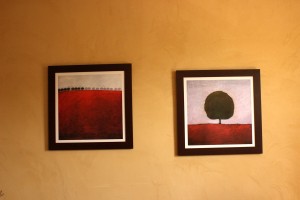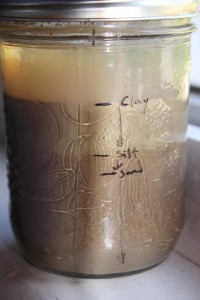As their name implies, binders glue the other elements of a plaster together. More than anything else the binder defines the properties of a plaster including strength, permeability, and resistance to weathering. Over thousands of years of natural plastering there are three major binders that have been traditionally used: clay, gypsum, and lime. There’s a lot of variation within all three. Lime in particular is further categorized into hydrated lime, natural hydraulic lime, and natural cement; all of which have very distinct properties and are considered as unique binders. But for simplicity let’s look at the properties and origins of the three major binders first, and then break them down into further categories.The table below summarizes some of the properties of the trinity of natural binders, as well as portland cement and a portland-lime blend (recognizing that portland cement is not a natural plaster, but has been used in natural building).
| Binder | Vapour Permeability (US Perm/inch) | Weathering Resistance | Strength | Embodied energy |
| Clay | Excellent (18) | Poor | Weak | Low |
| Gypsum | Excellent (18) | Very poor | Weak | Low-Medium |
| Lime | Good (14) | Good | Strong | Medium |
| Cement-Lime | Poor (7-10) | Very good | Strong but brittle | High |
| Cement | Very Poor (1) | Very good | Strong but brittle | Very High |
Now let’s look at each binder more closely.
Clay

Clay is usually considered to be the most ecological of all binders, because it can be dug from the ground and used as-is; or even when it is mined and sold industrially, the energy cost of processing it is typically lower than other binders, which are mined and then heated to relatively high temperatures to achieve their binding properties. Clay plasters, or earth plasters, are the most vapour permeable of all the natural plasters, and the most flexible – they readily allow humidity to pass through, and adapt to movements of the substrate without cracking. These properties are important when plastering over natural wall systems. Clay also has the interesting property of readily taking in water, but when it is saturated it becomes rather waterproof and prevents further water penetration. However earth plasters trade these virtues for lower strength and erosion resistance – wet clay may be water proof, but under driving rain it will erode relatively quickly. Clay also has very high shrinkage as it dries, so earth plasters are either applied very thin, or contain large amounts of fiber and/or aggregate.
Clay is the product of many thousands of years of erosion of rocks (particularly feldspar), and the deposition of very fine particles, often on ancient lakebeds. Sometimes clay deposits are formed at or near the source rocks, and are relatively pure – these are called primary clays. More often they are transported by water and deposited far away on the beds of ancient lakes, where they are typically a blend of many minerals – these are called secondary clays. Clay is primarily composed of the mineral kaolinite (Al2O3•2SiO2•2H2O) but with widely varying quantities of aluminates and silicates, as well as oxides of iron, calcium, magnesium and many other compounds / impurities. But this doesn’t tell us much about what clay actually is – which is incredibly fine particles that are typically flattened into miniature platelets. It is the interaction of these platelets that gives clay its properties.
The platelets are easily lubricated with a layer of water, so that they stick together very strongly, and yet readily slide over each other – making clay extremely plastic and malleable when wet, yet quite hard when it dries out and this lubricating layer is gone. Clays vary in the size of their particles, and generally clays with very fine particle sizes have high plasticity, and high strength because the clay has a lot of binding power. Unfortunately this goes hand in hand with higher rates of shrinkage. The most extreme example of this is bentonite clay, which has such fine particle size that it behaves quite differently than other clay. Bentonite is typically 10 times finer than any other clay; it can have a surface area of almost 1000 square meters per gram. The very high rates of shrinkage, high plasticity, and extremely low permeability generally make bentonite totally unusable in natural plasters.
On the other hand if you’re using pottery clay, you’ll probably want to use some of the most plastic pottery clays, the ball clays, which are fantastic for mixing with lots of aggregate and fiber to make a strong base coat that can be laid quite thick on the wall. Kaolin clays, which are much less plastic, are often used in thin finish plasters for their desirable white colour and very low silica content – it’s very important to realize that most clay contains significant amounts of silica, so the dust is little safer to breathe than portland cement dust. Clays that lack plasticity (called short clays) will tend to break rather than bending when wet, and generally speaking are less desirable for plaster (but this rule is often broken). When you’re using clays dug up on site, however, they are rarely so pure – your biggest concern will be ratio of clay to non-clay elements in the soil
If you’re looking for recipes for clay plasters, you’ll want to get this book
Evaluating soil types
The most important property of your soil, when assessing it for plaster, is the clay content. Ideally soils used in earth plasters should contain 20-30% clay or more. It may be possible to make a good plaster with as little as 10-20% clay content in your soil, but proceed with caution, particularly at the lower end, because your plaster will be weaker. Particles that are slightly large than clay are called silt, which is often mistaken for clay because it has the same slippery feel when wet – however it lacks the binding properties. Silt can be either benign or very harmful in plaster, depending on how much there is. As a rule It should equal less than 1/4 of the clay content of your soil, so if your clay content is 20% the maximum amount of silt should be 5%; any more than this and there’s a chance of plaster failure. Plasterers will certainly break this rule, but be careful and make a lot of samples You should aim to use the best soil possible for your plaster, even if it means trucking it in or using bagged clay- plastering a house costs thousands of dollars, so if you’re going to experiment, do it on a shed.
There are several ways to test your soil, you should use all of them and compare the results. You may want to compare soil from a few different places on your site, as it can sometimes vary over short distances.
The ribbon testMake a ball of clay that is malleable and not-too-wet, not-too-dry; squeeze it between thumb and forefinger to produce a ribbon about 1/8 inch (2-3 mm) thick and less than ½ inch (about 1 cm) wide. Keep pushing the ribbon out to see how long you can extend it before it breaks. A minimum of 1 ½ inches (40 cm) usually indicates at least 20% clay, but to be safe it would be good to have a ribbon double that length. Evaluate the feel as you squeeze it: does it feel smooth and plastic, can you feel sand grains in it? Is the sand fine or coarse, sharp or rounded? Next do the jar test to get even more detailed information about your soil.
The jar test
The jar test is a fairly accurate and easy way to determine your soil type, but it takes time because clay can take up to a week to settle out of suspension. Any jar will work for this test, but a 1 litre mason jar is a nice size. Fill the jar no more than 1/3 full with soil, then top it up to at least ¾ full with water (leave enough air space to get a good shake). Optionally you can add some detergent or salt to help disperse the clay particles. Shake the jar well, until you feel that any soil clumps have broken up. If not using a dispersant, you’ll likely want to let it soak for a day or more, and come back to shake it again. Note that it should be shaken, not stirred; swirling will tend to throw off the accuracy slightly. Have a timer (with an alarm) and a permanent marker handy. Shake for several minutes; start the timer when you stop shaking. After 40 seconds all of the sand component of the soil will have settled out – mark this level on the side of the jar. After 2 hours all of the silt will have settled out, mark another line at this level. Wait until the water starts to look clear (up to a week), at which point all, or nearly all of the clay will have settled out. Measure the height of each layer and divide it by the total height to obtain a percentage by volume of the soil. The measurement of clay will be a little high, because clay continues to compact over time, and even more so when it dries. For more accuracy you may carefully scoop off most of the remaining water and leave the jar to evaporate in the sun for a few days.
Clay plasters are fun, but because of the varying properties of soil, fiber and aggregate it can feel more like art than science. Different regions can also have very different clay soils, which makes knowledge sharing a little more complicated.
In part 2 we’ll look at gypsum and lime, and talk a little about cement. I’ll also share some links.
If you found this article useful you’ll probably want to read our book Essential Natural Plasters.


Leave a Reply